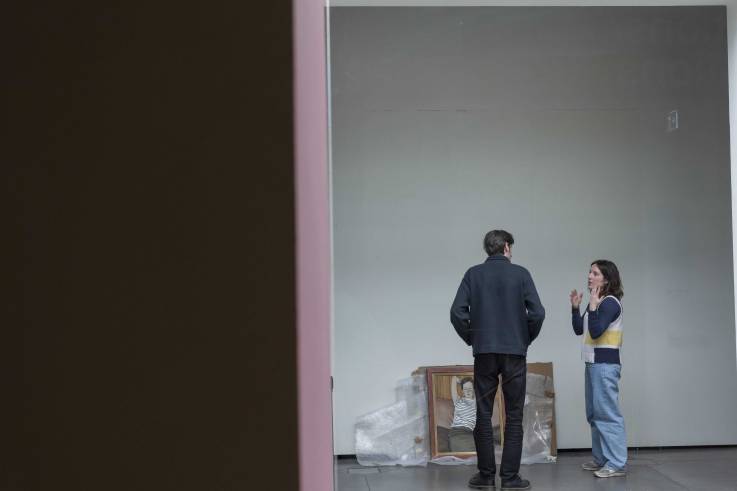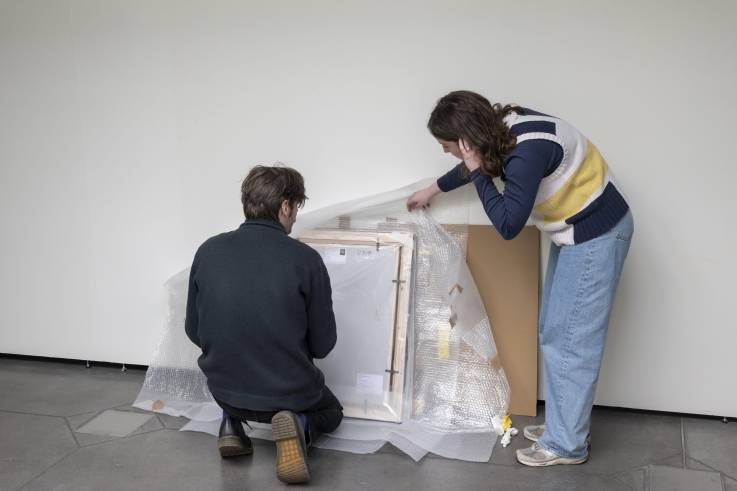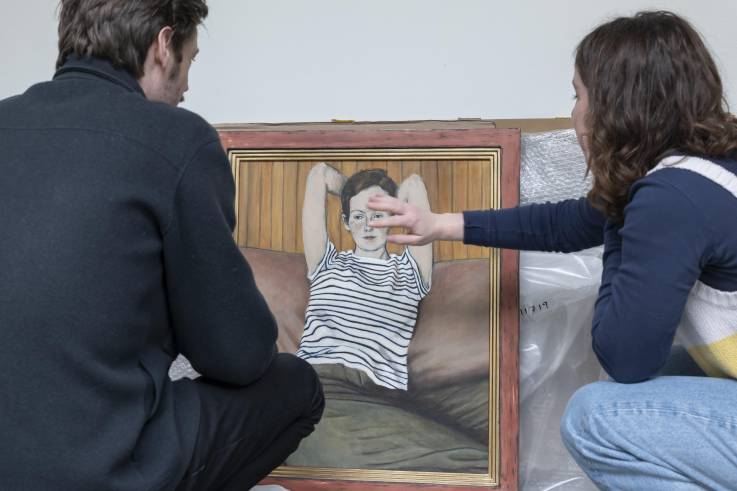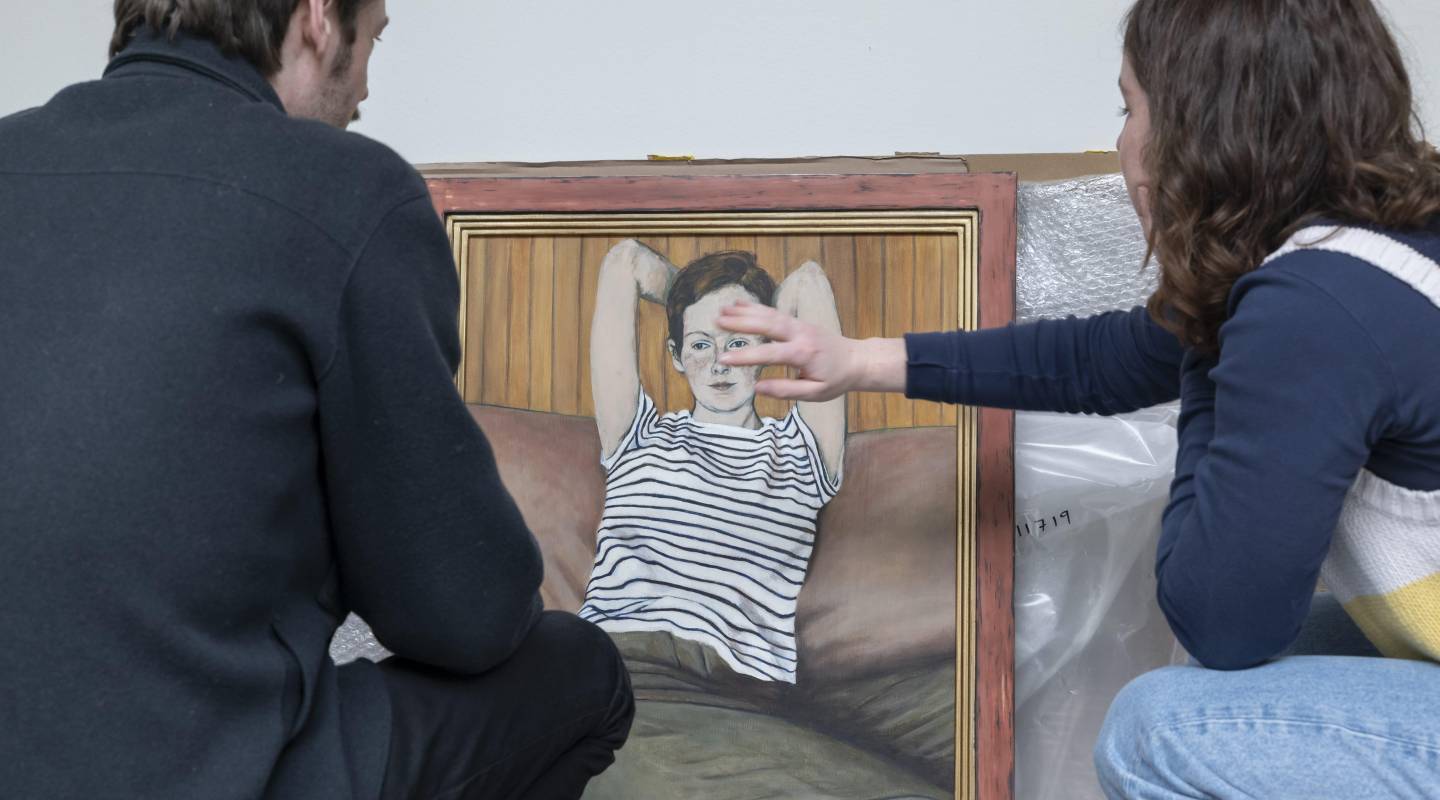With the careful eye of a restorer and the vision of a painter, Dan Gaasch’s 2022 portrait Selina offers a fresh, contemporary take on the classic portrait. Selected for the renowned Herbert Smith Freehills Portrait Award at the National Portrait Gallery in London (NPG) in 2024, the painting captures the artist’s partner, Selina, in a moment of stillness and reflection.
With its delicate mix of form, colour and texture, the piece draws you in, inviting you to pause and consider both the subject and the artist’s careful formal execution and composition. Almost a year after its recognition at the NPG, Selina has now found its permanent place in the MNAHA’s collection, marking an important journey from London to its new home. I had the chance to catch up with the artist a few weeks ago at the museum when he brought the painting in, and we got to chat about his work and creative process.

Selina’s journey
The Herbert Smith Freehills Portrait Award is dedicated to contemporary portrait painting and is open to artists worldwide. In its 42nd edition in 2024, it showcased 50 selected works from 1.647 submissions across 62 countries. The jury, chaired by Nicholas Cullinan, former director of the NPG and now director of the British Museum, included prominent figures such as the gallery’s contemporary art curator. Tanya Bentley and British artist Barbara Walker. As Cullinan notes in the exhibition’s leaflet: “The anonymity applied to this process encouraged the judges to consider what resonated for them most, including the artist’s technical ability, their use of symbolism and narrative, and their application of colour, texture and shadows.”
It was through this careful selection process that Dan Gaasch’s portrait made it through to the final cut. Interestingly, Selina was not only included in the NPG’s exhibition, but also chosen as one of the key images for its promotion, appearing on flyers, postcards and posters. As Gaasch tells me, there’s a real sense of joy in seeing Selina’s journey now come full circle. Just a year ago, he got the news that his work had been selected for the group show at the NPG, and now, one year later, it’s here in the museum, officially part of the MNAHA’s permanent collection, securing its place in the history of art from Luxembourg.

A restorer’s point of view
Born in Luxembourg in 1988, Gaasch has a rather unique background for an artist, one that doesn’t follow a traditional trajectory. Instead, his career combines both practical expertise and a deep understanding of art history, giving him a keen eye for formal expression and craftsmanship. After studying Art History in Freiburg im Breisgau, he went on to train in the restoration and conservation of paintings and polychrome sculptures at the Staatliche Akademie der Bildenden Künste in Stuttgart. This formal education in restoration has left a clear mark on his artistic practice, with specific attention given to the materiality of his works. Thus, Gaasch pays close attention to composition, the use of colour and its translucency or opacity, and, in the case of this painting, also the frame, which is an integral part of the work.
The composition of Selina seems both intimate and carefully constructed, guiding the viewer’s attention to the sitter’s contemplative expression and relaxed posture. There’s a touch of Neue Sachlichkeit about it; certainly no surprise, given Gaasch’s background as a restorer, which allowed him to gain extensive knowledge from countless encounters with artworks up close. The overall colour palette is muted, with the white of Selina’s T-shirt standing out against the greens, beiges and browns that dominate the rest of the piece. Gaasch points out that he avoided using black, instead choosing green tones to partially contour her face and the upper part of the couch. The surface of the painting reveals traces of the creative process, with visible brushstrokes, priming and glimpses of the canvas peeking through in places. The layers of paint are clearly noticeable, giving the work an uneven texture that adds real depth and character to the piece.

Creating tension in form
From a formal perspective, the interplay of lines in this portrait is particularly striking. The horizontal stripes of the t-shirt contrast with the vertical stripes of what appears to be wooden panels in the background, while the folds in the trousers introduce some additional diagonal lines. The lines in the background even echo the shape of the frame, which, as Gaasch explains, he crafted himself with the help of a master gilder. You can hear the excitement in his voice as he talks about the process, thoughtfully describing each step he took to create this unique frame, a so-called Künstlerrahmen.
It’s this the mix of patterns that creates an interesting visual dynamic, adding a sense of tension that acts as a counterpoint to the otherwise calm mood of the painting. It also gives the work a very contemporary feel, bringing something fresh to a genre with such a long tradition in art history. In our conversation, Gaasch tells me that it’s really the act of painting and the dialogue with the medium that serves as the starting point for his work, perhaps more so than the subject matter. Funny enough, although Gaasch doesn’t exclusively focus on portraits, the first painting he ever did was, you guessed it, a portrait of Selina.
Text: Lis Hausemer / Images: Eric Chenal
Source: MuseoMag N° II - 2025
Don’t miss the chance to see Selina up close in the upcoming New in! talks on the 4th floor of the museum, where I’ll be presenting the work in person on 7 May and 4 June. It will also be featured in the new permanent display of art in Luxembourg, set to open this autumn.
